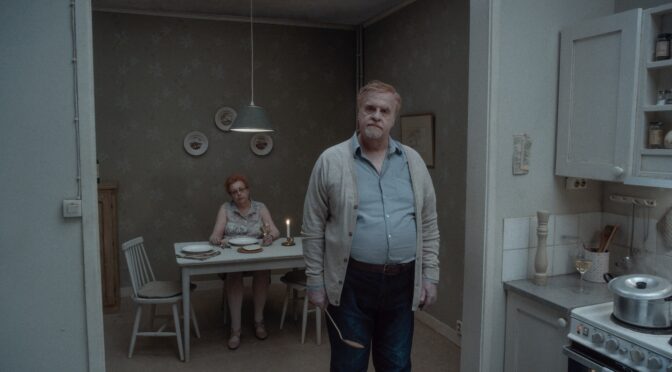 The distinctive style of Roy Andersson was forged over several films, from early commercial sketches, through his 1991 short film WORLD OF GLORY, and what’s become known as “the Living Trilogy,” comprising SONGS FROM THE SECOND FLOOR, YOU, THE LIVING, and most recently A PIGEON AT ON A BRANCH REFLECTING UPON EXISTENCE. With the last of these, it might have been thought a stylistic conclusion was reached: the feel of the scenes and the punchlines within them were already becoming, while never diminishing in pleasure, a bit repetitious.
The distinctive style of Roy Andersson was forged over several films, from early commercial sketches, through his 1991 short film WORLD OF GLORY, and what’s become known as “the Living Trilogy,” comprising SONGS FROM THE SECOND FLOOR, YOU, THE LIVING, and most recently A PIGEON AT ON A BRANCH REFLECTING UPON EXISTENCE. With the last of these, it might have been thought a stylistic conclusion was reached: the feel of the scenes and the punchlines within them were already becoming, while never diminishing in pleasure, a bit repetitious.
ABOUT ENDLESSNESS is a risky film for Andersson because it operates in the same vignette style and with mostly the same sense of rhythm, the same affected performances, the same quirked decor, and character make-up. But the film’s mood, or more precisely, the film’s variance between moods, is more so than in his previous work. Andersson is prepared to sit with his characters’ dismays and despairs, as ever, but ABOUT ENDLESSNESS displays more ambivalence and, for a change, a few scenes of untrammelled happiness. There’s just a lot of unhappiness to get through before that point.
The film opens with a couple floating through the clouds, who reappear later in the film still floating, this time over a grand European city in ruins: the pair are embracing like the two in Marc Chagall’s painting Over the Town. After this, sketches are mostly introduced by a woman’s voice, quickly reporting on the life the film’s exacting scheme will frame next. “I saw a…” she begins, and over 75 minutes, she’ll recall her meetings with a woman who loved champagne, a woman who had a problem with her shoe, a man who was unlucky in love, and many others. In fact, the anaphoric sentence structure of her introductions, after a while, begins to sound like Bob Dylan’s “A Hard Rain’s A-Gonna Fall,” with its ready reprises of lines beginning with “I saw,” “I heard,” “I met.”
Single-take vignettes, with few camera movements, often with music in the background which began playing a scene before, contain everything in the film, from the slightest observation to the profound despondency: a man making dinner for his wife, annoyed by an old classmate who ignores him; a dentist is pissed off at his patient’s moaning, walking promptly out of the room with a harrumphing “goodbye!”; an army of prisoners are marching through the snows of Siberia; a priest, who has lost his faith in God, doing mass moments after scarfing down the communion wine; and most joyously, three women stop outside a cafe and dance. There’s range for you.
But this isn’t randomised. ABOUT ENDLESSNESS coheres around its characters’ disappointments, and in all but the happiest or most indifferent vignettes, the people within these scenes are all abandoned to some degree. A woman exiting a train, hoping for someone to be on the platform to greet her is one: she takes a seat, and a short beat later, a man comes, and they walk off together. There’s the lower degree. Here’s the higher: a man is on a busy bus, sobbing. Passengers are looking around nervously. He speaks, telling anyone within earshot, “I don’t know what I want!” In the clipped, mewling delivery of the line, it’s possible at first to miss the utter terror that inspires it. But being abandoned by your desires in life is no laughing matter.
Those other passengers, looking awkwardly around for a solution to this man’s tears, are not rare in the director’s films. Andersson is interested in bystanders; people who let things happen when they could act and prevent them. Essential to this theme is a scene in a market, just next to a fishmonger’s stand. People are waiting around, when a man accosts a woman next to him: he slaps her. Those nearby shift their stances as if to step in, but don’t; it’s only after he continues that a pair restrain him, but the majority of the witnesses have stood stock-still the entire time. It doesn’t seem like an enormous leap from here to the director’s interest in the roots of fascism, always lurking in YOU, THE LIVING, and which surfaces in this film in a surprising, and surprisingly direct, way.
If ABOUT ENDLESSNESS is more of the same from Andersson, whose work is the strange offspring of Samuel Beckett and Jacques Tati, then it’s hard to see why that’s not altogether positive. Like Mae West said: “Too much of a good thing can be wonderful.”

